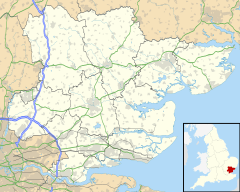Kelvedon Hatch facts for kids
Quick facts for kids Kelvedon Hatch |
|
|---|---|
 St Nicholas, Kelvedon Hatch |
|
| Area | 0.647 km2 (0.250 sq mi) |
| Population | 2,434 (2019 estimate, BUA) 2,541 (2011 Census parish) |
| • Density | 3,762/km2 (9,740/sq mi) |
| OS grid reference | TQ576986 |
| Civil parish |
|
| District |
|
| Shire county | |
| Region | |
| Country | England |
| Sovereign state | United Kingdom |
| Post town | BRENTWOOD |
| Postcode district | CM15 |
| Dialling code | 01277 |
| Police | Essex |
| Fire | Essex |
| Ambulance | East of England |
| EU Parliament | East of England |
| UK Parliament |
|
Kelvedon Hatch is a small village in Essex, England. It is located north of Brentwood and is surrounded by a special protected area called the Metropolitan Green Belt. This means the land around the village is kept natural and open.
In 2019, about 2,434 people lived in the main built-up area of Kelvedon Hatch. The village is famous for the Kelvedon Hatch Secret Nuclear Bunker. This is the biggest and deepest Cold War bunker in South East England that you can visit! There's also a special nature spot called The Coppice, Kelvedon Hatch, which is a Site of Special Scientific Interest because of its important wildlife.
Contents
Village History
The name "Kelvedon Hatch" has been around for a very long time. It was written in the Domesday Book as "Kelenduna," "Kalenduna," or "Kelvenduna." This old name likely means "Speckled Hill."
For many centuries, from the Middle Ages until the mid-1900s, most people in Kelvedon Hatch worked in farming. Records from 1871 show that most families were involved in agriculture. However, as railways made it easier to travel, many young people moved to bigger towns like Ongar and Brentwood. This led to a decline in local farming.
Kelvedon Hall and Other Big Houses
One of the most important buildings in the village's history is Kelvedon Hall. It was first mentioned in the Domesday Book, which was a big survey of England made in 1086.
In 1538, a farmer named John Wright bought the manor (the estate and its land). His family owned it for nearly 400 years! The main house was rebuilt in the 1700s. Later, in 1937, Sir Henry 'Chips' Channon and his wife bought the property. They worked to restore the house and added new features like the entrance gate. During World War II, Kelvedon Hall was used as a special home for people recovering from injuries.
Other large houses in the area include Brizes, which dates back to the late 1400s. The building you see today was built around 1720. There's also Great Myles, named after a person called Miles de Muntenay. This house was also mentioned in the Domesday Book, but most of it was taken down in 1837. A few smaller buildings from it are still there.
To the west of Kelvedon Hatch is Dudbrook Hall. This house was built in 1602. During World War II, it was used to house RAF officers who worked at nearby airfields. Today, it is a care home for older people.
The old church in the village, St Nicholas, was a medieval church. It was replaced by a newer Victorian church in 1895.
Famous People from Kelvedon Hatch
- Sarah Kane: A famous playwright (someone who writes plays). She used the name "Marie Kelvedon" as a pen name for one of her plays.
- Sir Henry Channon: Often called Chips Channon, he was a politician from the Conservative party. He was also a writer and kept a diary.
- Baron Kelvedon: He was a British politician and a member of the Privy Council, a group of advisors to the King or Queen.
See also
 In Spanish: Kelvedon Hatch para niños
In Spanish: Kelvedon Hatch para niños


